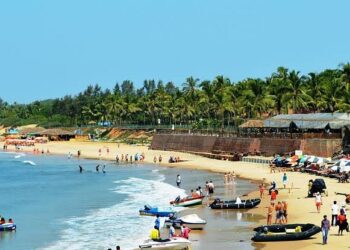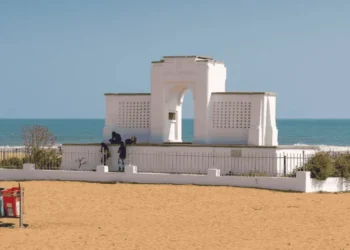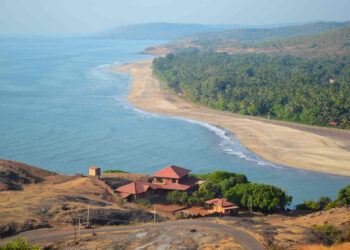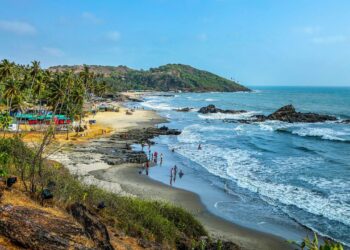In Oel town, Lakhimpur Kheri district, Uttar Pradesh, near the Saraswati River, the Narmadeshwar Mandir, also called the Frog Temple, is a sacred place where folks come to pray to Lord Shiva. It is the only temple in the country where Lord Shiva is depicted sitting on the back of a frog, and where the frog itself is also worshipped. The temple is built on the principles of Manduk Tantra, a branch of Tantric tradition that considers the frog a symbol of prosperity, luck, and fertility.
History of Narmadeshwar Mandir
The Narmadeshwar Mandir was built between 1860 and 1870 by Raja Bakhat Singh, the ruler of Oel. Located in Lakhimpur Kheri, a land steeped in ancient Hindu traditions, the temple was said to be established in honor of Lord Shiva after a frog blessed the king with wealth and children. Historical records mention that the temple follows the Manduk Tantra, a tantric tradition, and is considered India’s only temple dedicated to frogs. The Shivling inside the temple was brought from Narmada Kund, a place associated with the worship of Banasur, as noted in local documents.
The temple stands on level ground and is approached by ten stone steps. British writers in the 1800s remarked on its unusual appearance. After India’s independence in 1947, a local trust took over its care. Renovations in the 1990s preserved its original look. Saints of earlier times praised Shiva’s glory here, spreading the temple’s fame. Today, many devotees visit this sacred site in Lakhimpur.
Legends of Narmadeshwar Mandir
The temple is surrounded by many local stories about Shiva. One well-known tale says Raja Bakhat Singh, who had no children, met a tantric baba who told him to build a temple for Shiva by offering a frog as a sacrifice. The frog brought him luck and children, so the temple was built on the spot where the frog was offered. People believe that Shiva’s spirit, along with the frog, watches over the land. They say praying here with a pure heart brings wealth and removes troubles, as frogs are seen as symbols of good fortune in tantric stories.
Another tale says the shivling changes color, showing Shiva’s power. People in the area share stories of miracles—finding health, peace, or help with problems after praying here—which keeps the temple holy. Some believe a nearby pond holds the hidden power of the frog. These stories, handed down over time, bring many devotees across India seeking Shiva’s blessings.
It is also believed that offering milk to the shivling five times can make wishes come true. Many feel the air around the temple carries Shiva’s protective strength, making it a place of care. On Shivratri, devotees say Shiva’s spirit grows especially strong here.
Architecture of Narmadeshwar Mandir
The Narmadeshwar Mandir sits on one acre in Oel, made in a plain tantric style. The main part has a low dome top, carved with frogs, crocodiles, and Shiva’s trident, all in black stone. Inside, the shivling, 3 feet tall, sits on a square base with a frog statue, lit by oil lamps. A 5-foot frog statue at the gate faces north, and the temple sits on its back, with a crocodile below.
A small hall has four stone pillars, carved with tantric marks like yantras and gods. Small shrines for Parvati, Ganesh, and Hanuman are in the yard, made of stone. The Parvati shrine shows her with a lotus. The Ganesh one, from 1870, shows him with a modak, for wisdom. The Hanuman one shows him with a mace, for strength. The stone yard feels holy, near the Saraswati. A plain gate has Shiva’s face. A water ghat, Saraswati’s edge, is 3 kilometers off for ritual dips. Walls have tantric verses carved in Hindi, guiding those who pray. A garden with a peepal tree gives calm.
Rituals and Festivals
The temple is lively during festivals. Shivratri in February is celebrated with night-long singing and milk offerings to the shivling. Diwali, in October or November, is observed by lighting lamps for Shiva. In Shravan, which falls in July or August, the Shivling is bathed every day with water and milk. During Shivratri, the temple courtyard fills with devotional chants, songs, and bhajans, making the atmosphere very sacred.
The nearby Saraswati ghat draws many visitors who believe taking bath in the river wash away sins from multiple births. Devotees bring offerings of milk, bel leaves, and marigold flowers. Some chant the Shiva Tandava Stotra, a ritual to please Lord Shiva. Free meals are served during festivals, feeding thousands of people, ranging from 3,000 to 8,000.
Information for Travelers
Hours and Entry: Open every day, 6:00 AM to 8:00 PM. It’s free to go in, but prayers cost ₹50–150. No pictures in the main hall. Clothing: Wear clothes covering shoulders and knees. Women for prayers wear sarees or suits, while men wear kurtas.
How to Get There:
Air: Lucknow Airport is roughly 130 kilometers from the temple, with flights to Delhi (around 1 hour) and Mumbai (around 2 hours). Taxis from the airport take about 3 hours to reach the temple.
Train: Lakhimpur Station lies 14 kilometers away and has rail connections to Lucknow (approximately 3 hours) and Delhi (around 10 hours). Auto-rickshaws are available for travel within the area.
Road: Oel lies 130 kilometers from Lucknow on National Highway 24. Buses run between Lucknow and Oel, and auto-rickshaws operate within the town. Parking is available for a small number of vehicles.
Best Time to Visit: October to March is cool, 15–25°C. Weekdays are quiet. Shivratri’s busy, with 5,000–15,000 visitors, so come early.
Nearby Attractions
Gola Gokaran Nath Temple: 35 km away, a Shiva shrine called Chhoti Kashi.
Sankata Devi Temple: 12 km away, a Durga shrine from 1800s.
Dudhwa National Park: 80 km away, a tiger reserve for nature.
Final Words
The Narmadeshwar Mandir in Oel, Lakhimpur Kheri, is a unique temple where visitors come for its special stories, simple architecture, and peaceful atmosphere. This temple offers a deep connection to India’s ancient faith and culture making it a must visit temple in your travel list.











